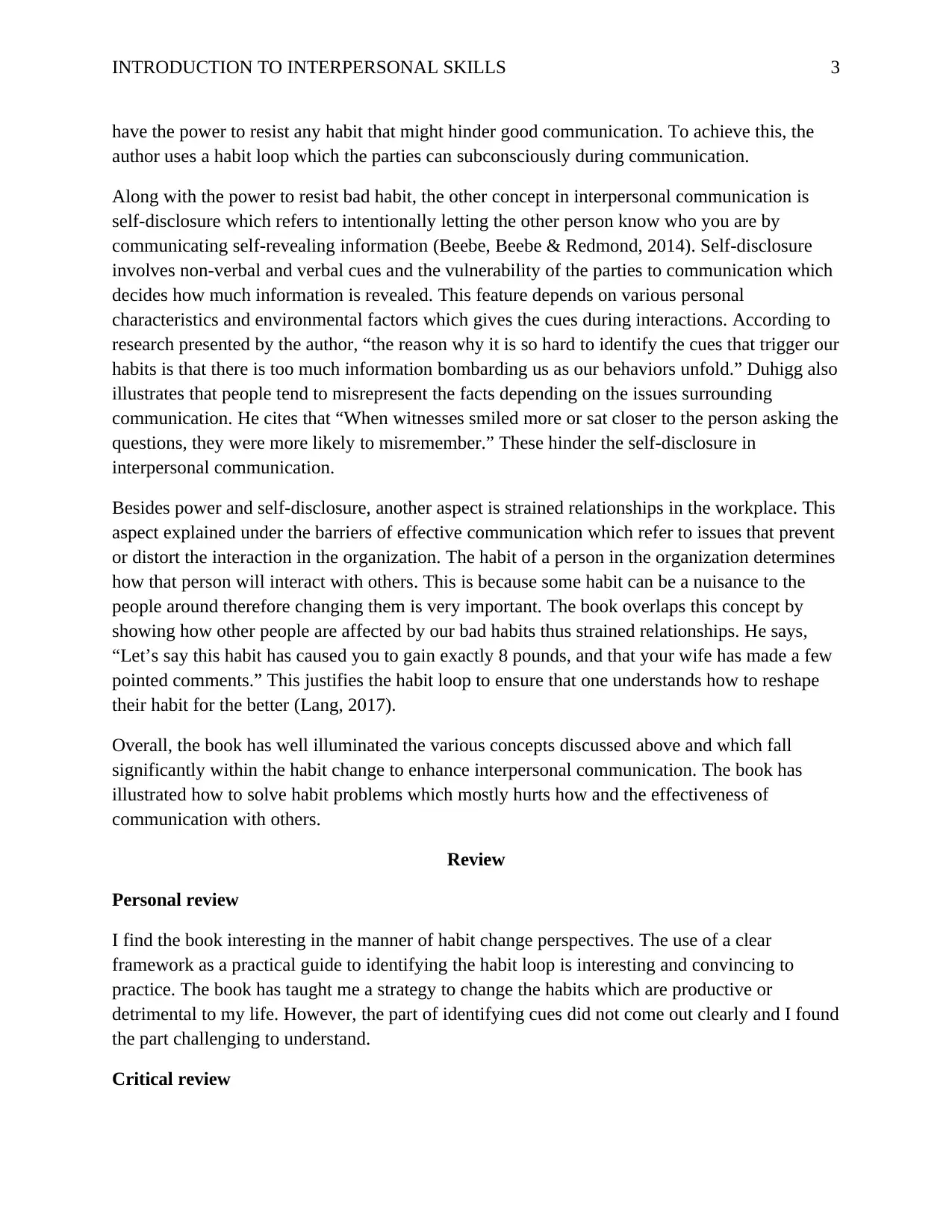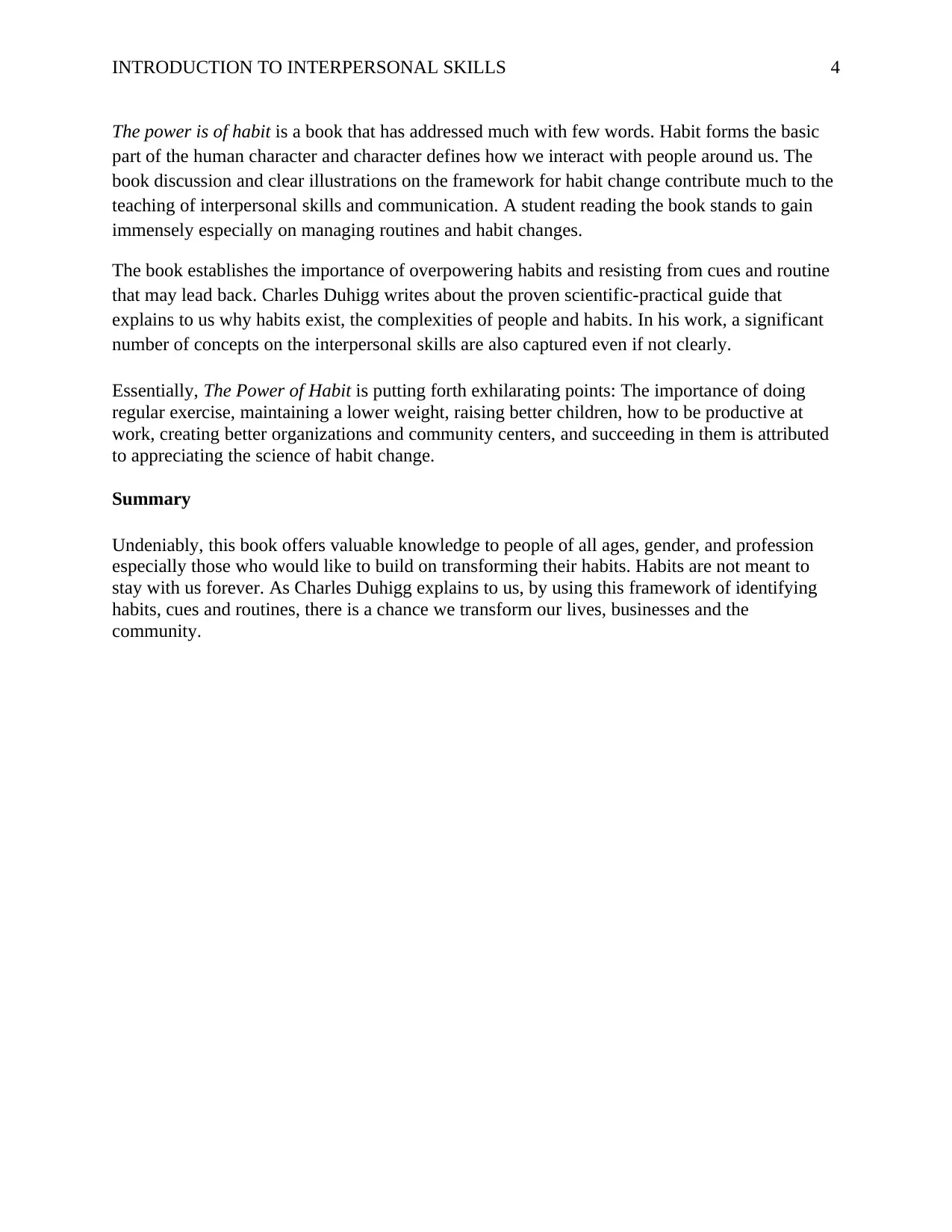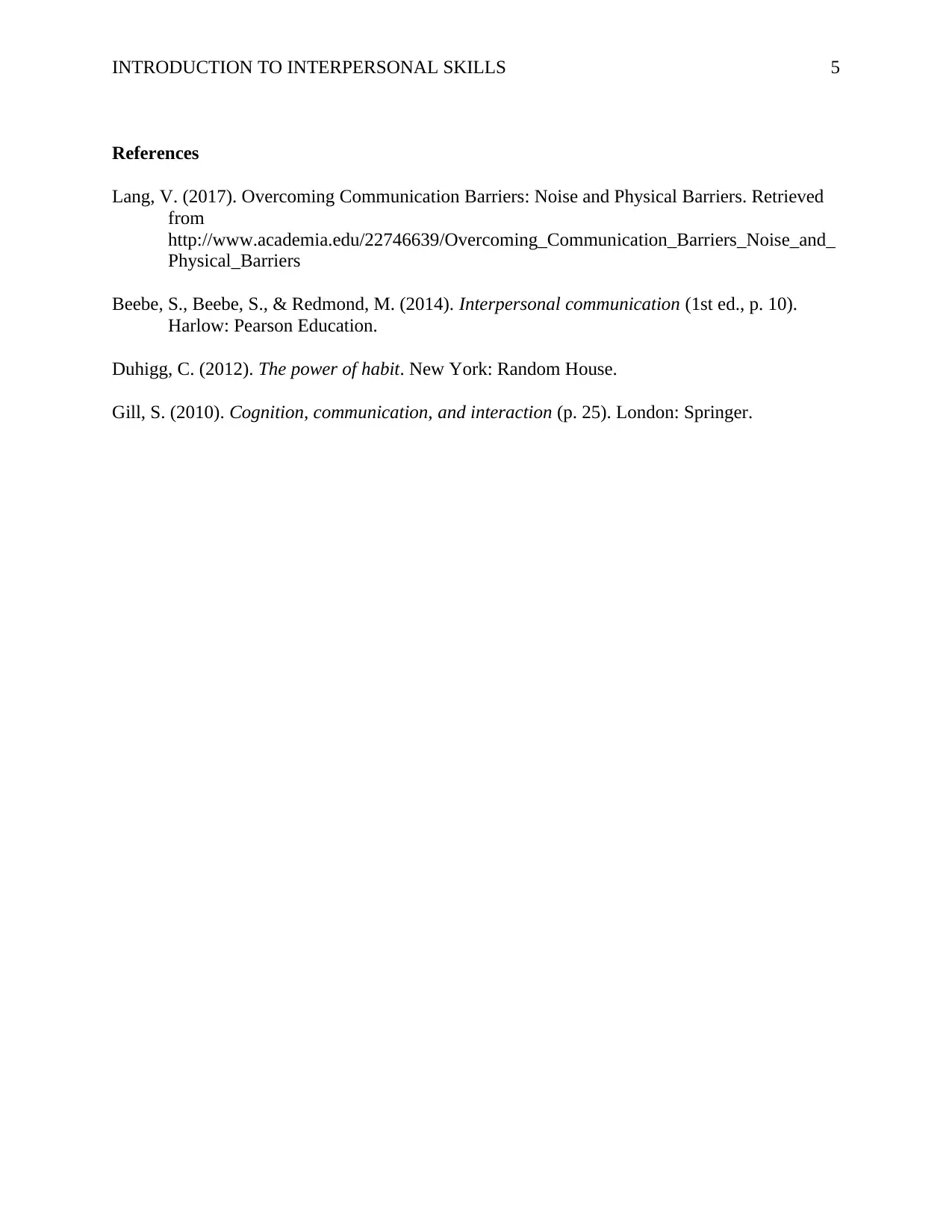The Power of Habit Book Review
VerifiedAdded on 2023/06/09
|5
|1497
|271
AI Summary
Read a comprehensive review of The Power of Habit book by Charles Duhigg. Learn how to break bad habits and reshape them using a scientific-practical framework. Discover how the book overlaps with interpersonal skills concepts.
Contribute Materials
Your contribution can guide someone’s learning journey. Share your
documents today.

Running head: INTRODUCTION TO INTERPERSONAL SKILLS 1
Introduction to Interpersonal Skills
Student’s Name
Institution
Introduction to Interpersonal Skills
Student’s Name
Institution
Secure Best Marks with AI Grader
Need help grading? Try our AI Grader for instant feedback on your assignments.

INTRODUCTION TO INTERPERSONAL SKILLS 2
Summary
The power of habit book by Charles Duhigg is one of the practical books on how to break the
habit. The author explains why habit exists and how we can change if not eliminating them. He
starts by pointing out that there are numerous scientific practices on how one can change a habit
but there is no single method that is more reliable than the other considering the complexities of
human behaviors and different habits(Duhigg, 2012).
Duhigg provides a scientific-practical framework for diagnosing and reshaping habits in our
lives. To start with, the framework consists of identifying the routine, experiment with rewards,
isolate the cue and have a plan. Basically, these are the steps to follow when diagnosing the habit
to reach a point of changing it. The first step is identifying the routine in which there is a habit
loop consisting of three parts: a cue, a routine, and a reward. Each of these is discussed in details
to show how each influences the other and how altering the cycle assists in reshaping the habit.
Second is experimenting with rewards. Here, Duhigg gives illustrations like going to the
cafeteria and buy a cookie and chat with people. In this case, a cookie is the reward to satisfy the
craving. To change this habit, you have to change the reward so that you identify the craving at a
particular time. The third is isolating the cues which lead to a particular routine. At this point, the
author uses the illustration on how people are likely to misrepresent the fact due to various
events happening in their life while others are capable of giving a chronology of events with
significant accuracy. To identify the cue, the author states that, one has to scrutinize the patterns
of events that lead to the behavior. The last in the framework is the plan on how to alter the cues,
routines and eventually the habit. The plan involves changing the timing of occurrence of events,
routines, and habits. For instance, instead of going to the cafeteria between 3:00 and 4:00, you
can interchange that timing to do other things like chatting with a colleague in the office.
However, he points out that changing habits various and some can be difficult to change but the
understanding of the framework gives the power to overpower the habits (Duhigg, 2012).
Application of class concepts
The book resonates well with the learning of interpersonal skills. In this case, various
interpersonal skills concepts can be explained in reference to the book illustrations. In this
section, concepts of power, self-disclosure, and strained relationships will be discussed.
Power in the interpersonal communication refers to the ability to control what happens, to
influence things to happen the way you want, and to shield what you don’t want to happen
during the process of communication. The parties to the communication have this power over
their way of communication and interaction. The overlap is observed where the author provides a
framework for reshaping the habit. In this respect, the parties to the communication identify the
habit loop that affects their effective communication hence the areas of weakness during
interactions (Gill, 2010). Duhigg says that “Tomorrow, you promise yourself, you’ll muster the
will-power to resist. Tomorrow will be different.” This means that during interaction both parties
Summary
The power of habit book by Charles Duhigg is one of the practical books on how to break the
habit. The author explains why habit exists and how we can change if not eliminating them. He
starts by pointing out that there are numerous scientific practices on how one can change a habit
but there is no single method that is more reliable than the other considering the complexities of
human behaviors and different habits(Duhigg, 2012).
Duhigg provides a scientific-practical framework for diagnosing and reshaping habits in our
lives. To start with, the framework consists of identifying the routine, experiment with rewards,
isolate the cue and have a plan. Basically, these are the steps to follow when diagnosing the habit
to reach a point of changing it. The first step is identifying the routine in which there is a habit
loop consisting of three parts: a cue, a routine, and a reward. Each of these is discussed in details
to show how each influences the other and how altering the cycle assists in reshaping the habit.
Second is experimenting with rewards. Here, Duhigg gives illustrations like going to the
cafeteria and buy a cookie and chat with people. In this case, a cookie is the reward to satisfy the
craving. To change this habit, you have to change the reward so that you identify the craving at a
particular time. The third is isolating the cues which lead to a particular routine. At this point, the
author uses the illustration on how people are likely to misrepresent the fact due to various
events happening in their life while others are capable of giving a chronology of events with
significant accuracy. To identify the cue, the author states that, one has to scrutinize the patterns
of events that lead to the behavior. The last in the framework is the plan on how to alter the cues,
routines and eventually the habit. The plan involves changing the timing of occurrence of events,
routines, and habits. For instance, instead of going to the cafeteria between 3:00 and 4:00, you
can interchange that timing to do other things like chatting with a colleague in the office.
However, he points out that changing habits various and some can be difficult to change but the
understanding of the framework gives the power to overpower the habits (Duhigg, 2012).
Application of class concepts
The book resonates well with the learning of interpersonal skills. In this case, various
interpersonal skills concepts can be explained in reference to the book illustrations. In this
section, concepts of power, self-disclosure, and strained relationships will be discussed.
Power in the interpersonal communication refers to the ability to control what happens, to
influence things to happen the way you want, and to shield what you don’t want to happen
during the process of communication. The parties to the communication have this power over
their way of communication and interaction. The overlap is observed where the author provides a
framework for reshaping the habit. In this respect, the parties to the communication identify the
habit loop that affects their effective communication hence the areas of weakness during
interactions (Gill, 2010). Duhigg says that “Tomorrow, you promise yourself, you’ll muster the
will-power to resist. Tomorrow will be different.” This means that during interaction both parties

INTRODUCTION TO INTERPERSONAL SKILLS 3
have the power to resist any habit that might hinder good communication. To achieve this, the
author uses a habit loop which the parties can subconsciously during communication.
Along with the power to resist bad habit, the other concept in interpersonal communication is
self-disclosure which refers to intentionally letting the other person know who you are by
communicating self-revealing information (Beebe, Beebe & Redmond, 2014). Self-disclosure
involves non-verbal and verbal cues and the vulnerability of the parties to communication which
decides how much information is revealed. This feature depends on various personal
characteristics and environmental factors which gives the cues during interactions. According to
research presented by the author, “the reason why it is so hard to identify the cues that trigger our
habits is that there is too much information bombarding us as our behaviors unfold.” Duhigg also
illustrates that people tend to misrepresent the facts depending on the issues surrounding
communication. He cites that “When witnesses smiled more or sat closer to the person asking the
questions, they were more likely to misremember.” These hinder the self-disclosure in
interpersonal communication.
Besides power and self-disclosure, another aspect is strained relationships in the workplace. This
aspect explained under the barriers of effective communication which refer to issues that prevent
or distort the interaction in the organization. The habit of a person in the organization determines
how that person will interact with others. This is because some habit can be a nuisance to the
people around therefore changing them is very important. The book overlaps this concept by
showing how other people are affected by our bad habits thus strained relationships. He says,
“Let’s say this habit has caused you to gain exactly 8 pounds, and that your wife has made a few
pointed comments.” This justifies the habit loop to ensure that one understands how to reshape
their habit for the better (Lang, 2017).
Overall, the book has well illuminated the various concepts discussed above and which fall
significantly within the habit change to enhance interpersonal communication. The book has
illustrated how to solve habit problems which mostly hurts how and the effectiveness of
communication with others.
Review
Personal review
I find the book interesting in the manner of habit change perspectives. The use of a clear
framework as a practical guide to identifying the habit loop is interesting and convincing to
practice. The book has taught me a strategy to change the habits which are productive or
detrimental to my life. However, the part of identifying cues did not come out clearly and I found
the part challenging to understand.
Critical review
have the power to resist any habit that might hinder good communication. To achieve this, the
author uses a habit loop which the parties can subconsciously during communication.
Along with the power to resist bad habit, the other concept in interpersonal communication is
self-disclosure which refers to intentionally letting the other person know who you are by
communicating self-revealing information (Beebe, Beebe & Redmond, 2014). Self-disclosure
involves non-verbal and verbal cues and the vulnerability of the parties to communication which
decides how much information is revealed. This feature depends on various personal
characteristics and environmental factors which gives the cues during interactions. According to
research presented by the author, “the reason why it is so hard to identify the cues that trigger our
habits is that there is too much information bombarding us as our behaviors unfold.” Duhigg also
illustrates that people tend to misrepresent the facts depending on the issues surrounding
communication. He cites that “When witnesses smiled more or sat closer to the person asking the
questions, they were more likely to misremember.” These hinder the self-disclosure in
interpersonal communication.
Besides power and self-disclosure, another aspect is strained relationships in the workplace. This
aspect explained under the barriers of effective communication which refer to issues that prevent
or distort the interaction in the organization. The habit of a person in the organization determines
how that person will interact with others. This is because some habit can be a nuisance to the
people around therefore changing them is very important. The book overlaps this concept by
showing how other people are affected by our bad habits thus strained relationships. He says,
“Let’s say this habit has caused you to gain exactly 8 pounds, and that your wife has made a few
pointed comments.” This justifies the habit loop to ensure that one understands how to reshape
their habit for the better (Lang, 2017).
Overall, the book has well illuminated the various concepts discussed above and which fall
significantly within the habit change to enhance interpersonal communication. The book has
illustrated how to solve habit problems which mostly hurts how and the effectiveness of
communication with others.
Review
Personal review
I find the book interesting in the manner of habit change perspectives. The use of a clear
framework as a practical guide to identifying the habit loop is interesting and convincing to
practice. The book has taught me a strategy to change the habits which are productive or
detrimental to my life. However, the part of identifying cues did not come out clearly and I found
the part challenging to understand.
Critical review

INTRODUCTION TO INTERPERSONAL SKILLS 4
The power is of habit is a book that has addressed much with few words. Habit forms the basic
part of the human character and character defines how we interact with people around us. The
book discussion and clear illustrations on the framework for habit change contribute much to the
teaching of interpersonal skills and communication. A student reading the book stands to gain
immensely especially on managing routines and habit changes.
The book establishes the importance of overpowering habits and resisting from cues and routine
that may lead back. Charles Duhigg writes about the proven scientific-practical guide that
explains to us why habits exist, the complexities of people and habits. In his work, a significant
number of concepts on the interpersonal skills are also captured even if not clearly.
Essentially, The Power of Habit is putting forth exhilarating points: The importance of doing
regular exercise, maintaining a lower weight, raising better children, how to be productive at
work, creating better organizations and community centers, and succeeding in them is attributed
to appreciating the science of habit change.
Summary
Undeniably, this book offers valuable knowledge to people of all ages, gender, and profession
especially those who would like to build on transforming their habits. Habits are not meant to
stay with us forever. As Charles Duhigg explains to us, by using this framework of identifying
habits, cues and routines, there is a chance we transform our lives, businesses and the
community.
The power is of habit is a book that has addressed much with few words. Habit forms the basic
part of the human character and character defines how we interact with people around us. The
book discussion and clear illustrations on the framework for habit change contribute much to the
teaching of interpersonal skills and communication. A student reading the book stands to gain
immensely especially on managing routines and habit changes.
The book establishes the importance of overpowering habits and resisting from cues and routine
that may lead back. Charles Duhigg writes about the proven scientific-practical guide that
explains to us why habits exist, the complexities of people and habits. In his work, a significant
number of concepts on the interpersonal skills are also captured even if not clearly.
Essentially, The Power of Habit is putting forth exhilarating points: The importance of doing
regular exercise, maintaining a lower weight, raising better children, how to be productive at
work, creating better organizations and community centers, and succeeding in them is attributed
to appreciating the science of habit change.
Summary
Undeniably, this book offers valuable knowledge to people of all ages, gender, and profession
especially those who would like to build on transforming their habits. Habits are not meant to
stay with us forever. As Charles Duhigg explains to us, by using this framework of identifying
habits, cues and routines, there is a chance we transform our lives, businesses and the
community.
Secure Best Marks with AI Grader
Need help grading? Try our AI Grader for instant feedback on your assignments.

INTRODUCTION TO INTERPERSONAL SKILLS 5
References
Lang, V. (2017). Overcoming Communication Barriers: Noise and Physical Barriers. Retrieved
from
http://www.academia.edu/22746639/Overcoming_Communication_Barriers_Noise_and_
Physical_Barriers
Beebe, S., Beebe, S., & Redmond, M. (2014). Interpersonal communication (1st ed., p. 10).
Harlow: Pearson Education.
Duhigg, C. (2012). The power of habit. New York: Random House.
Gill, S. (2010). Cognition, communication, and interaction (p. 25). London: Springer.
References
Lang, V. (2017). Overcoming Communication Barriers: Noise and Physical Barriers. Retrieved
from
http://www.academia.edu/22746639/Overcoming_Communication_Barriers_Noise_and_
Physical_Barriers
Beebe, S., Beebe, S., & Redmond, M. (2014). Interpersonal communication (1st ed., p. 10).
Harlow: Pearson Education.
Duhigg, C. (2012). The power of habit. New York: Random House.
Gill, S. (2010). Cognition, communication, and interaction (p. 25). London: Springer.
1 out of 5
Your All-in-One AI-Powered Toolkit for Academic Success.
+13062052269
info@desklib.com
Available 24*7 on WhatsApp / Email
![[object Object]](/_next/static/media/star-bottom.7253800d.svg)
Unlock your academic potential
© 2024 | Zucol Services PVT LTD | All rights reserved.